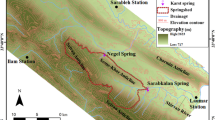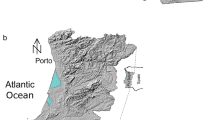Abstract
Karst aquifers supply drinking water for 25 % of the world’s population, and they are, however, vulnerable to climate change. This study is aimed to investigate the effects of various monsoons and teleconnection patterns on Niangziguan Karst Spring (NKS) discharge in North China for sustainable exploration of the karst groundwater resources. The monsoons studied include the Indian Summer Monsoon, the West North Pacific Monsoon and the East Asian Summer Monsoon. The climate teleconnection patterns explored include the Indian Ocean Dipole, E1 Niño Southern Oscillation, and the Pacific Decadal Oscillation. The wavelet transform and wavelet coherence methods are used to analyze the karst hydrological processes in the NKS Basin, and reveal the relations between the climate indices with precipitation and the spring discharge. The study results indicate that both the monsoons and the climate teleconnections significantly affect precipitation in the NKS Basin. The time scales that the monsoons resonate with precipitation are strongly concentrated on the time scales of 0.5-, 1-, 2.5- and 3.5-year, and that climate teleconnections resonate with precipitation are relatively weak and diverged from 0.5-, 1-, 2-, 2.5-, to 8-year time scales, respectively. Because the climate signals have to overcome the resistance of heterogeneous aquifers before reaching spring discharge, with high energy, the strong climate signals (e.g. monsoons) are able to penetrate through aquifers and act on spring discharge. So the spring discharge is more strongly affected by monsoons than the climate teleconnections. During the groundwater flow process, the precipitation signals will be attenuated, delayed, merged, and changed by karst aquifers. Therefore, the coherence coefficients between the spring discharge and climate indices are smaller than those between precipitation and climate indices. Further, the fluctuation of the spring discharge is not coincident with that of precipitation in most situations. Karst spring discharge as a proxy can represent groundwater resource variability at a regional scale, and is more strongly influenced by climate variation.










Similar content being viewed by others
References
Appenzeller C, Stocker TF, Anklin M (1998) North Atlantic oscillation dynamics recorded in Greenland ice cores. Science 282:446–449
Beynen P, Feliciano N, North L, Townsend K (2007) Application of a karst disturbance index in Hillsborough County, Florida. Environ Manag 39(2):261–277
China Preparatory Committee for United Nations Conference on Sustainable Development (2012) The People’s Republic of China National Report on sustainable development. People’s Publishing House, Beijing
Ford DC, Williams PW (2007) Karst hydrogeology and geomorphology. Wiley, Chichester
Gams I, Nicod J, Julian M, Anthory E, Sauro U (1993) Environmental change and human impacts on the Mediterranean karsts of France, Italy and the Dinaric Region. In: Williams PW (ed) Karst terrians: environmental changes, human impact: catena supplement 25. Catena Verlag, Cremlingen-Destedt, Germany
Gedalof Z, Smith DJ (2001) Interdecadal climate variability and regime-scale shifts in Pacific North America. Geophys Res Lett 28:515–1518
Grinsted A, Moore JC, Jevrejeva S (2004) Application of the cross wavelet transform and wavelet coherence to geophysical time series. Nonlinear Process Geophys 11(5/6):561–566
Guo Q, Wang Y, Ma T, Li L (2005) Variation of karst springs discharge in recent five decades as an indicator of global climate change: a case study at Shanxi, northern China. Sci China D Earth Sci 48(11):2001–2010
Gurdak JJ, Hanson RT, McMahon PB, Bruce BW, McCray JE, Thyne GD, Reedy RC (2007) Limate variability controls on unsaturated water and chemical movement, High Plains Aquifer, USA. Vadose Zone J 6(2):533–547. doi:10.2136/vzj/2006.0087
Han X, Lu R, Li Q (1993) Karst water system: a study on big karst spring in Shanxi. Geological Publishing House, Beijing (in Chinese)
Hanson RT, Newhouse MW, Dettinger MD (2004) A methodology to assess relations between climatic variability and variations in hydrologic time series in the southwestern United States. J Hydrol 287(1):252–269
Hartmann A, Goldscheider N, Wagener T, Lange J, Weiler M (2014) Karst water resources in a changing world: review of hydrological modeling approaches. Rev Geophys 52:218–242. doi:10.1002/2013RG000443
Heinz B, Birk S, Liedl R, Geyer T, Straub KL, Andresen J, Bester K, Kappler A (2008) Water quality deterioration at a karst spring (Gallusquelle, Germany) due to combined sewer overflow: evidence of bacterial and micro-pollutant contamination. Environ Geol 57(4):797–801
Holman IP, Rivas-Casado M, Bloomfield JP, Gurdak JJ (2011) Identifying non-stationary groundwater level response to North Atlantic ocean-atmosphere teleconnection patterns using wavelet coherence. Hydrogeol J 19:1269–1278. doi:10.1007/s10040-011-0755-9
Hu C, Hao Y, Yeh T-CJ, Pang B, Wu Z (2008) Simulation of spring flows from a karst aquifer with an artificial neural network. Hydrol Process 22(5):596–604
Intergovernmental Panel on Climate Change (IPCC) (2007) Climate change 2007: synthesis report. IPCC, Geneva, Switzerland
Intergovernmental Panel on Climate Change (IPCC) (2012) Summary for policy makers. In: Field CB et al (eds) Managing the risks of extreme events and disasters to advance climate change adaptation. Cambridge University Press, Cambridge
Jemcov I (2007) Water supply potential and optimal exploitation capacity of karst aquifer systems. Environ Geol 51(5):767–773
Kriechbaumer T, Angus A, Parsons D, Casado MR (2014) An improved wavelet-ARIMA approach for forecasting metal prices. Resour Policy 39:32–41
Kuss AJM, Gurdak JJ (2014) Groundwater level response in U.S. principal aquifers to ENSO, NAO, PDO and AMO. J Hydrol 519:1939–1952
Labat D (2010) Cross wavelet analyses of annual continental freshwater discharge and selected climate indices. J Hydrol 385(1–4):269–278
Leibundgut C (1998) Vulnerability of karst. In: Karsaquiferst Hydrology, vol 247. IAHS Publication, Wallingford, pp 45–60
Li YH, Zhao QY (2000) Effect of ENSO on the autumn rainfall anomaly in northwest China. Clim Environ Res 5(2):205–213 (in Chinese)
Liang Y, Han X, Xue F (2008) Water resources conservation for karst spring basin of Sbahxi Provinc. China Water and Power Press, Beijing (in Chinese)
Milly PCD, Betancourt J, Falkenmark M, Hirsch RM, Kundzewicz ZW, Lettenmaier DP, Stouffer RJ (2008) Stationarity is dead: whither water management? Science 319(1):573–574
Partal T, Kucuk M (2006) Long-term trend analysis using discrete wavelet components of annual precipitation measurements in Marmara region (Turkey). Phys Chem Earth 32:1189–1200
Perez-Valdivia C, Auchyn D, Vanstone J (2012) Groundwater levels and teleconnection patterns in the Canadian Prairies. Water Resour Res 48:W07516. doi:10.1029/2011WR010930
Sauro U (1993) Human impact on the karst of the Venetian Fore-Alps, Italy. Environ Geol 21(3):115–121
Takio K (2014) Principal component analysis (PCA). In: Katsushi I (ed) Computer vision. Springer, New York, pp 636–639
Taylor R, Scanlon B, Döll P, Rodell M, Beek RV, Wada Y, Longuevergne L, LeBlanc M, Famiglietti J, Edmunds M, Konikow L, Green TR, Chen J, Taniguchi M, Bierkens MFP, MacDonald A, Fan Y, Maxwell RM, Yechieli Y, Gurdak JJ, Allen D, Shamsudduha M, Hiscock K, Yeh PJ-F, Holman I, Treidel H (2013) Groundwater and climate change. Nat Climate Change. doi:10.1038/nclimate1744
Torrence C, Compo GP (1998) A practical guide to wavelet analysis. Bull Am Meteorol Soc 79(1):61–78
Torrence C, Webster PJ (1999) Interdecadal changes in the ENSO-monsoon system. J Clim 12(8):2679–2690
Tremblay L, Larocque M, Anctil F, Rivard C (2011) Teleconnections and interannual variability in Canadian groundwater levels. J Hydrol 410:178–188
Wu C, Liu H (2005) Interdecadal characteristics of the influence of northward shift and intensity of summer monsoon on precipitation over northern China in summer. Plateau Meteorol 24(5):657–665 (in Chinese)
Yang X, Guan Z (2007) Role of Indian Ocean Dipole events in the influence of ENSO on the summer rainfall and temperature in China. J Nanjing Inst Meteorol 30(2):170–177 (in Chinese)
Yuan C (1982) Calculation of recharge rates of Niangziguan Springs Basin by using Turc equation. Karst and karst groundwater in northern China. Geological Publishing House, Beijing, pp 122–126 (in Chinese)
Acknowledgments
This work is partially supported by the National Natural Science Foundation of China 41272245, 41402210, 40972165, and 40572150, and China Scholarship Council 201508120014. Our thanks extend to Dr. Yoshiyuki Kajikawa for providing the monthly mean data of ISM and WNPM indices, and Professor Jianping Li for providing the monthly mean data of EASM index. The authors sincerely thank two anonymous reviewers for their detailed and constructive comments to improve this manuscript.
Author information
Authors and Affiliations
Corresponding author
Rights and permissions
About this article
Cite this article
Zhang, J., Hao, Y., Hu, B.X. et al. The effects of monsoons and climate teleconnections on the Niangziguan Karst Spring discharge in North China. Clim Dyn 48, 53–70 (2017). https://doi.org/10.1007/s00382-016-3062-2
Received:
Accepted:
Published:
Issue Date:
DOI: https://doi.org/10.1007/s00382-016-3062-2




